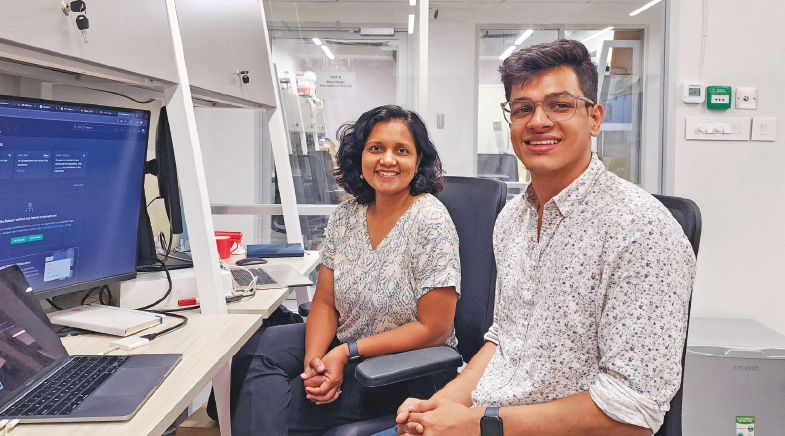When hearts beat in sync, work gets done better
-
- from Shaastra :: vol 03 issue 06 :: Jul 2024

People perform better at group tasks when their heart rates and brain waves are in sync.
The world looked different to K.M. Sharika while she was serving as Research Associate in cognitive science at the University of Pennsylvania. She was struck by the change in the weather and food, and the differences she noticed in the work environment and personal interactions. She had expected cultural differences, but not to such an extent, she recalls. "I sensed a gap," says Sharika, adding that she may have been more sensitive to these differences than others.
The experiences, however, got her thinking: "How do people navigate such situations and what makes some people better at it than others?" Sharika started reading up about the subject. Coincidentally, around the same time in 2016, The New York Times Magazine published an article on how Google was looking at what made groups of people or teams more productive than individuals (bit.ly/groups-NYT).
The article triggered a chain of thought and action. Sharika observed how scientists studied group dynamics; she sought out people who worked in this area; she looked at the tools they used — and the information she garnered sharpened her interest in the field.
The flow of unshared information in a group often depended on who was aware of it. If the group leader was privy to it, it got repeated.
Sharika consulted her post-doctoral adviser, Michael Platt, suggesting a side project that looked at what made people work effectively in groups. Platt, who is the James S. Riepe University Professor of Neuroscience, Professor of Psychology, and Professor of Marketing at the university, saw practical value in this line of research. "He gave me free rein to do whatever I wanted as long as I could manage it. That is how it began," she says.
The side project led to a paper in May 2024 (bit.ly/groups-Sharika) in PNAS. The study noted that in a group, when the members' heart rates were synchronised, they were found to be better at group tasks. Heart rate synchrony acts as a biomarker for interpersonal engagement and effective information-sharing during a group task. "I see it as a metric of what is behaviourally going on between group members," says Sharika, who is now an Assistant Professor in the Department of Cognitive Science, Indian Institute of Technology Kanpur.
For the study, Sharika and her colleagues assigned a task to groups of 4-6 people. They were given an instruction sheet, which carried some information that was common to all group members, and some information that was shared with only a few. The task derived inspiration from an organisational behaviour task known as 'hidden profile', where some information was equally shared, and some selectively. Researchers looked at the flow of information during the discussions that followed. Classically, researchers noted that the shared information got repeated the most number of times, and was eventually discussed the most. The selective information, on the other hand, came up later in the discussions — if at all — and, when it did, was not repeated as often as the shared information. The flow of the unshared information also often depended on who was aware of it. If the group leader was privy to it, it got repeated and accepted in the group more often than information shared by a person who was relatively new to the group. This implied that there were social costs associated with asserting oneself when new in a group.
Using the same paradigm, Sharika wanted to capture these trends to assess the physiological parameters that corresponded to sharing information. "I just wanted to add a physiological component to this whole paradigm and see if we could capture some of the dynamics related to groups that were able to pursue unique information," she says. The task was designed in such a way that only when the unshared information was discussed, and adequately considered by the group, were its members able to arrive at the right answer to the issue under discussion.
CLUES IN PHYSIOLOGY
As the participants performed the task, the researchers studied their heart rates using a method called recurrence quantification analysis. It allowed the researchers to create a combined measure of everybody's heart rate in the group and see how it varied in relation to each other over time. The recurrence quantification analysis, as its name suggests, quantifies the duration and number of recurrences in a dynamic system. For this study, the combined heart rate of all members of the group was considered as a dynamic system. The researchers monitored this system to see how often it revisited a state in its past. The revisits or recurrences reflected how often the system had been in the same state as before. This event of being in the same state as before, as a group, is called synchrony.

When the researchers looked at the heart rates of different groups, they saw that heart rate synchrony was an effective predictor of whether a group would complete a task. So, heart rate synchrony also became a proxy for interactions within the group and whether information was freely shared.
Studying physiological parameters such as heart rates can lead to a more objective understanding of the way a group functions. Previous studies on group dynamics, in organisational behaviour literature, have used self-reports — participants' own reports about their behaviour, beliefs, and attitudes — as their main tool of measurement. These reports were, of course, subjective. "We've found that self-reports alone are not able to predict group performance the way our heart rate synchrony measures alone can," Sharika says.
Another study studied synchrony in pairs of people. As the pairs synchronise their body movements during a discussion, more ideas are generated by the team.
Apart from heart rates, other physiological metrics such as brain waves also provide a way to assess interpersonal synchrony in a group. A 2021 study (bit.ly/brain-synchrony) by researchers from New York University used inter-brain synchrony to predict a group's collective performance. For the study, researchers randomly assigned groups of four to complete a series of problem-solving tasks, independently or as a team. As the participants worked on their tasks, the researchers recorded their brain activity with an electroencephalography hyperscanning set-up. "The teammates identified more strongly with one another, cooperated more on an economic game, and outperformed the average individual on most problem-solving tasks," the researchers noted.
According to Suzanne Dikker, one of the authors of the paper, the most interesting finding from that study was that inter-brain synchrony predicted group performances better than a self-report. "I think this is a very valuable finding that we see in some other realms of neuroscience as well, where information from neurophysiology might give a better prediction than people's self-reports. A lot of other conscious decision-making goes into the self-report that is not visible in the neurophysiological measurements," says Dikker, Research Associate Professor at the Max Planck-NYU Center for Language, Music and Emotion.
These neurophysiological signatures can throw light on interactions within families, too. Dikker will soon start work on a new project to look at cross-generational communication and how it relates to brain waves. The brain changes across a person's lifespan, as do the rhythms of brain waves. Dikker wants to study how these rhythmic changes in the brain impact cross-generational interactions, sense of closeness, etc. "We typically ignore the neurophysiological factors that might prevent us from being in sync with other generations," she says.
Another 2024 research effort (bit.ly/synchrony-pairs), published in Humanities & Social Sciences Communications, studied synchrony in pairs of people and found it to be associated with intellectual productivity. As more pairs synchronise their body movements during a discussion, more ideas are generated by the team, the researchers note in their paper.
The studies also highlight the importance of effective interpersonal interactions for the success of a team. In the past, the cognitive performance of groups was seen separately from social interactions. But cognitive processes are impacted by social factors, as Dikker explains. "We've been studying cognition and social interaction... separately, right? But some of the processes in our brains that are completely divorced from the social interaction are actually possibly impacted by social factors," she says.
WHY GROUPS MATTER
It is not just people in unfamiliar environments who are affected by group dynamics. From the time humans lived as hunter-gatherers to modern-day, cubicle-bound office workers, success has often hinged on working well with others. Factors that contribute to the success of groups or teams are universally important.
Studies such as the ones by Sharika and Dikker reveal some attributes of successful groups, but more research may be needed to identify the behavioural, psychological, and physiological features of groups that succeed as against those that don't. Eventually, these studies may pave the way for the development of an index to measure how effective a group of people would be.
What's clear, though, is that hearts that beat together work better together.
HEARTS THAT BEAT AS ONE
What lovers, mothers, infants and choir singers have in common.

It isn't only in workplace settings that heartbeat synchrony finds expression in happy outcomes. A 2012 study at the University of California, Davis, established that the heartbeats of those in romantic relationships, too, get in sync.
As part of the study (bit.ly/lovers-synchrony), 32 heterosexual couples were subjected to three tasks: baseline (seated in armchairs spaced three feet apart and made to relax for five minutes, without sleeping); gazing (where partners were asked to maintain eye contact with each other for three minutes without making facial gestures or bodily movements); and imitation (where they were asked to attempt to synchronise their physiological responses, or "mirror each other's physiology"). The researchers noted that except in the case of two couples, the heartbeat and respiration rates of the couples achieved synchrony. "...for most people, changes in heart rate and respiration were... related to their partners, in particular during tasks designed to elicit interactions between both partners," the study noted. "...the fact that coregulation was detectable... indicates that individuals adjust their physiology to that of their partners." This correlation was not observed when the couples were mismatched.

Similarly, three-month-old infants and their mothers "coordinate heart rhythms" during face-to-face interactions, according to a 2011 study (bit.ly/heartbeat-mom-child). As part of the study, mothers were instructed to play freely with the infant, seated facing her, for three minutes; face-to-face interactions were videotaped, and ECG signals of both mother and infant were recorded. The results demonstrated that "human mothers and infants engage in a process of bio-behavioral synchrony... Mothers adapt their heart rhythms to those of their infant's and infants, in turn, adapt their rhythms to those of the mother's... forming biological synchrony in the acceleration and deceleration of heart rate," it noted.

Likewise, a 2013 study (bit.ly/choir-heartbeat) of choir singers measured the heart rate variability and the respiratory rate, and established, somewhat intuitively, that "people who sing together tend to synchronize biologically in various respects". Unison singing of regular song structures "makes the hearts of the singers accelerate and decelerate simultaneously", it noted.
Have a
story idea?
Tell us.
Do you have a recent research paper or an idea for a science/technology-themed article that you'd like to tell us about?
GET IN TOUCH














